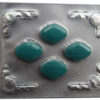Composition and Ingredients
Kamagra contains the active ingredient sildenafil citrate, a PDE5 inhibitor. Sildenafil is marketed in various strengths, typically ranging from 25 mg to 100 mg per tablet. Other ingredients may include microcrystalline cellulose, calcium hydrogen phosphate, croscarmellose sodium, magnesium stearate, and hypromellose. The product also contains titanium dioxide and lactose monohydrate as part of its excipients.
Mechanism of Action
Sildenafil citrate primarily acts by inhibiting the enzyme phosphodiesterase type 5 (PDE5), predominantly found in penile erectile tissue. The inhibition of PDE5 results in increased levels of cyclic guanosine monophosphate (cGMP). Elevated cGMP levels promote the relaxation of penile smooth muscles, allowing increased blood flow and aiding in achieving an erection. This action is dependent on sexual stimulation to initiate the release of nitric oxide from nerve endings and endothelial cells.
Indications for Use
Kamagra is indicated for the treatment of erectile dysfunction (ED) in adult men. ED is characterized by the inability to achieve or maintain an erection sufficient for satisfactory sexual performance. Kamagra may also be prescribed off-label for other conditions as determined by a healthcare provider. Patients must consult a healthcare provider to ascertain the appropriateness of Kamagra for their specific situation.
Recommended Dosage
The standard recommended dose of Kamagra is 50 mg, taken as needed approximately one hour before sexual activity. Based on efficacy and tolerability, the dose can be increased to 100 mg or decreased to 25 mg. It should not be taken more than once a day. Dosing adjustments may be necessary in patients with renal or hepatic impairment, as prescribed by a healthcare provider. The maximum recommended dosing frequency is once per day.
Administration Guidelines
Kamagra should be taken orally with a full glass of water. It can be ingested with or without food, but a high-fat meal might delay the medication’s onset. Patients should swallow the tablet whole without splitting or crushing it. For optimal results, sexual stimulation is required after taking the medication. Timing and dosage should be followed as directed by the prescribing physician to achieve desired outcomes.
Contraindications to Consider
Kamagra is contraindicated in patients with a known hypersensitivity to sildenafil or any of the tablet’s excipients. It should not be used alongside nitrates, such as those prescribed for angina, as this combination can lead to a dangerous drop in blood pressure. The use of Kamagra with inhibitors of the enzyme guanylate cyclase, such as riociguat, is not advised. It is also contraindicated in men for whom sexual activity is inadvisable due to cardiovascular risk factors.
Potential Drug Interactions
Consumption of Kamagra can interact with certain medications, leading to harmful effects. Interaction with organic nitrates can cause severe hypotension. Co-administration with alpha-blockers may result in symptomatic hypotension. Protease inhibitors, such as ritonavir and saquinavir, can increase plasma sildenafil concentration. Additionally, medications like erythromycin, cimetidine, and ketoconazole may affect sildenafil metabolism. Patients should inform their doctor of all medications, supplements, and herbal products they are taking.
Reported Side Effects
Common side effects of Kamagra include headache, flushing, dyspepsia, and nasal congestion. Some patients may experience dizziness, blurred vision, or changes in color vision. Rarely, more severe effects such as priapism, sudden hearing loss, and myocardial infarction may occur. Patients experiencing any concerning or persistent side effects should seek medical advice promptly. It is important to monitor for signs of allergic reactions, such as rash, itching, or swelling.
Overdose Concerns and Management
In cases of Kamagra overdose, symptomatic treatment should be provided as necessary. Symptoms may include severe dizziness, fainting, or prolonged and painful erection (priapism). Medical attention is imperative if an overdose is suspected. Dialysis is unlikely to be beneficial due to sildenafil’s high protein binding and extensive distribution into tissues. Supportive care and monitoring of vital signs are critical in managing overdose situations effectively.
Storage Requirements
Store Kamagra at room temperature, safeguarded from moisture and heat. The medication should be kept in its original packaging until ready for use to protect from light and humidity. Ensure the product is stored out of reach from children and pets. Disposal of unused or expired medication should adhere to local regulations to avoid accidental ingestion or environmental contamination. Proper storage will ensure the medication maintains its effectiveness up to its expiration date.
Clinical Monitoring Parameters
Patients on Kamagra should undergo periodic evaluation to assess the medication’s effectiveness and tolerability. Monitoring blood pressure and heart rate is advised due to potential cardiovascular side effects. Renal and hepatic function should be reviewed, especially in patients receiving prolonged treatment. Healthcare providers may also recommend vision and hearing assessments in individuals experiencing related adverse effects. Regular follow-up ensures ongoing suitability of treatment and early detection of adverse events.
Pharmacokinetic Profile
Kamagra is rapidly absorbed after oral administration, with peak plasma concentrations occurring within 30 to 120 minutes. Its bioavailability is approximately 40%, affected minimally by food. Sildenafil is metabolized primarily by the hepatic enzymes CYP3A4 and CYP2C9. The terminal half-life of sildenafil in healthy individuals is approximately 4 hours, facilitating once-daily administration. Its major metabolite, N-desmethylsildenafil, is active but less potent than sildenafil.
Specific Population Considerations
In elderly patients, Kamagra metabolism may be slower, warranting dose adjustments. Men with severe renal or hepatic impairment require careful dosage calculations to mitigate accumulation risks. For patients with anatomical deformations of the penis or conditions predisposing them to priapism, careful consideration and physician oversight are necessary. Kamagra is not approved for use in women or children, and its safety and efficacy in these populations have not been established.






Reviews
There are no reviews yet.